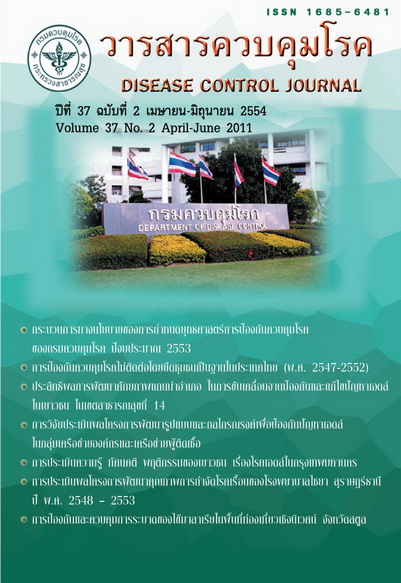Evaluation Research on Projects to Develop Model and Mechanism to Prevent HIV by NGO and People with HIV Networks
Keywords:
Strategy for disease prevention and control, PLWA network and NGOAbstract
In 2008, NGO-AIDS network and People with HIV network had initiated HIV prevention projects by developing knowledge and linking networks in localities. There were 5 implementing projects in this scheme receiving funds from the Subcommittee for Advancing the Prevention Programme Effort, National Health Security Office and Health System Research Institute. They were (1) Promotion of community organizational potentiality to manage HIV/AIDS problems, (2) Implementational campaign for HIV prevention in Ubonrajathanee, (3) Promotion of network working in HIV prevention to community organization, (4) Potentiality development for HIV worker, Thailand, (5) Sexual right communication for HIV prevention among people with HIV and community. The working group conducted evaluation research on these projects in 2009-2010 with objectives to assess their performance, and to synthesize knowledge for further recommendation. Data were collected using quantitative and qualitative methods, including document review, sampling of populations for focus group discussion, and questionnaire survey. Results from evaluation research were: 1.Main objective of implementing projects was to increase role of PHA and leaders of NGO-AIDS networks and participation of other networks in the community to develop and solve health problems in the community. 61.4 % of PHA leaders and community leaders answered correctly HIV/AIDS knowledge according to UNGASS indicator. 2. Innovations observed was creation of integrated networks working on HIV/AIDS and health in community. PHA networks served as core group. Promotion of sexual rights was also new to community. For sustainability, it is noted that areas where local administration organization got involved, there was an opportunity to access to fund in the locality. 3. All projects had strong coordination and administration system. However, some projects lacked of supporting team implementation. There was gap in internal communication. Recommendations include further development of policy to support integration of works against HIV/AIDS and health problems in community, and to support networks working in HIV/AIDS and health issues. For technical aspect, there should be additional attempts to synthesize knowledge gained from these projects for further dissemination. The leaders and teams in projects should receive continuous development. Support should also be provided to the develop project's administration to escalate efficiency of the projects.
Downloads
References
2. ศูนย์อำนวยการบริหารจัดการปัญหาเอดส์แห่งชาติ รายงานการประชุมคณะกรรมการแห่งชาติว่าด้วยการป้องกันและแก้ไขปัญหาเอดส์ ครั้งที่ 2/2550 วันที่ 2 เมษายน 2550.
3. เพชรศรี ศิรินิรันดร์ (บรรณาธิการ). การติดตามการดำเนินงานตามปฏิญญาว่าด้วยพันธกรณีเรื่องโรคเอดส์ แนวทางการสร้างตัวชี้วัดหลัก รายงานปี พ.ศ. 2553 (แปลจากหนังสือเรื่อง UNGASS Guidelines on Construction of Core Indicators
2010 Reporting). นนทบุรี: ศูนย์อำนวยการบริหารจัดการปัญหาเอดส์แห่งชาติ (ศบจอ.), พ.ศ. 2552.
4. การเฝ้าระวังพฤติกรรมที่สัมพันธ์กับการติดเชื้อเอชไอวี ปี พ.ศ. 2551. นนทบุรี: สำนักระบาดวิทยากรมควบคุมโรค กระทรวงสาธารณสุข, มีนาคม พ.ศ.2552 (พฤติกรรมกลุ่มประชากรทั่วไปปี 51)
5. การเฝ้าระวังพฤติกรรมที่สัมพันธ์กับการติดเชื้อเอชไอวีใน ประชากรกลุ่มต่างๆ และสถานการณ์ผู้ป่วยเอดส์ประเทศไทย ปี พ.ศ. 2552. นนทบุรี: สำนักระบาดวิทยา กรมควบคุมโรค กระทรวงสาธารณสุข, มีนาคม พ.ศ.2553.
6. พัชโรบล นาถประทาน. ประสบการณ์การรวมตัวกลุ่มผู้ติดเชื้อเอดส์ในภาคเหนือตอนบนประเทศไทย. เชียงใหม่: นพบุรีการพิมพ์, พ.ศ. 2541.
7. อุษา ดวงสา, ลิซ่า กันธมาลา, กุลธิดา จันทร์เจริญ, และคณะ. มกราคม พัฒนาการและบทเรียนของกลุ่ม และเครือข่ายผู้ติดเชื้อ (กรณีภาคเหนือตอนบน ประเทศไทย) คณะทำงานกรณีศึกษาที่ 4 พัฒนาการและบทเรียนของกลุ่มและเครือข่ายผู้ติดเชื้อ (กรณีภาคเหนือตอนบน ประเทศไทย).
8. ศูนย์บริการแบบองค์รวม เปลี่ยนบทบาทผู้ติดเชื้อ "ผู้รับบริการ" สู่ "ผู้ร่วมให้บริการ". http://www.thaiplus.net/autopage/ show_page.php?h=2&s_id=9&d_id=2 (มีนาคม พ.ศ.2553)
9. เครือข่ายผู้ติดเชื้อเอชไอวี/เอดส์ ประเทศไทย. http://www.thaiplus.net (มีนาคม พ.ศ.2553)
Downloads
Published
How to Cite
Issue
Section
License
Articles published in the Disease Control Journal are considered as academic work, research or analysis of the personal opinion of the authors, not the opinion of the Thailand Department of Disease Control or editorial team. The authors must be responsible for their articles.






